Submissions
Submission Preparation Checklist
As part of the submission process, authors are required to check off their submission's compliance with all of the following items, and submissions may be returned to authors that do not adhere to these guidelines.- The request has not been previously published, it has not been submitted to another journal (or an explanation has been provided in Comments to the Editor). Likewise, the reproduction rights of letter of assignment of rights are transferred.
- The file sent is in Microsoft Word format; Times New Roman source, 12 points; in double and justified line spacing; margins of 2, 54 cm. Normas para autoras/es
- The text includes the information of the author that corresponds to his academic background, institutional affiliation, email and have included the number corresponding to his ORCID.
- The length of the article is between 5,000 words and 15,000 words.
- The text includes title, abstract and keywords, which have an English version.
- The illustrations, figures and tables are inside the text in the place that corresponds to them and not at the end of the whole.
- Citations and references are in APA format.
- The article submitted to this journal is consistent with the themes of the journal Nuevo Derecho.
- The journal is known to comply with double blind peer evaluation and undergo this evaluation process.
- It is mandatory to complete and attach the "Author Information Form" and the "Letter of Text Publication Request" to the submission. Articles that do not include both documents properly completed will be discarded during the editorial process.
Artículo de Investigación
Document that presents, in detail, the original results of research projects. The general structure of the article must contain the following sections:
Title
Name of the Author (s)
Footer with the author's information: Academic training, institutional affiliation, ORCID, email.
Abstract / Abstract
Keywords / Keywords
Introduction
Methodology
(Results)
Conclusions
Bibliographic references
Artículo de Reflexión
Document that presents research results from an analytical, interpretative or critical perspective of the author, on a specific topic, using original sources. The general structure of the article must contain the following sections:
Title
Name of the Author (s)
Footer with the author's information: Academic training, institutional affiliation, ORCID, email.
Abstract / Abstract
Keywords / Keywords
1. Introduction
2. (Contents)
Conclusions
Bibliographic references
Artículo de Revisión
Document resulting from a documentary research in which the results of published or unpublished research are analyzed, systematized and integrated, on a field in science or technology, in order to account for progress and development trends. It is characterized by presenting a careful bibliographic review of at least 50 references.
Title
Name of the Author (s)
Footer with the author's information: Academic training, institutional affiliation, ORCID, email.
Abstract / Abstract
Keywords / Keywords
1. Introduction
2. (Contents)
Conclusions
Bibliographic references
Reseña
It is a document that presents the analysis of a chosen text through the presentation of the structure of the analyzed book, proposing a criticism of its content and a reflection on its themes.
Title
Name of the Author (s)
Footer with the author's information: Academic training, institutional affiliation, ORCID, email.
Abstract / Abstract
Keywords / Keywords
1. Introduction
2. Analysis of the analyzed text
3. (Content)
Conclusions
Bibliographic references
Articulo corto
Documento breve que presenta resultados originales preliminares o parcialesde una investigación científica o tecnológica, que por lo general requieren de una prontadifusión.Traducción
Traducciones de textos clásicos o de actualidad o transcripciones de documentoshistóricos o de interés particular en el dominio de publicación de la revista.Book Review
The aim of this section of the journal is to create a space for authors to be able to comment on, review and expand on topics addressed in texts that contribute to academic discussion.
Copyright Notice
Authors should declare that the article is an original work that has not been totally or partially published in any print or electronic media, which has not been submitted simultaneously to another publication and that is not currently under evaluation in another publication. On the other hand, I leave (we) evidence that the statements made therein are the sole responsibility of the / the authors / is.
All data and references to already published material are properly identified with their respective credit and included in the bibliographical notes and appointments that stand out as such and, in cases that require it, I have the proper authorizations for those with the respective rights; in case of any dispute or claim relating to intellectual property rights, we take responsibility exonerating responsibility to Nuevo Derecho.
If the article is approved for publication, the authors transfer the copyright to the journal New law to publish, distribute electronic copies and included in indexing services, directories or databases of national and international data on Open Access under the Creative Commons 3.0 Attribution-Noncommercial (CC bY-NC-SA) by which the authors retain their copyrights and allow them to others copy and distribute your work provided they recognize the corresponding authorship and the work is not used for purposes commercial.
Therefore, new law does not retain the rights to reproduce or copy (copyright), so the authors will have the final versions, to disseminate them in institutional repositories, personal blogs or any other electronic or print media, with the sole condition to make mention of the original source of publication, in this case Nuevo Derecho.
Privacy Statement
The names and email addresses entered in this journal will be used exclusively for the purposes stated by this journal and will not be available for any other purpose or other person.



